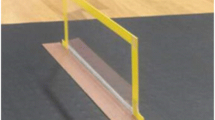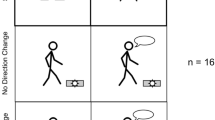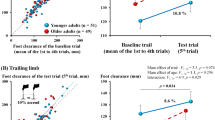Abstract
The aim of this research was to describe age-related changes in locomotor adjustments during obstructed gait and expand and build from the current body of literature describing single obstacle avoidance strategies by including trials in which the subjects stepped over two identical obstacles placed in series. We observed young adults (YA: N = 8; aged 23.1 ± 2.0 years) and older adults (OA: N = 8; aged 76.1 ± 4.3 years) as they walked along a 5 m long instrumented pathway (GAITRite) and stepped over one or two obstacles that were scaled to their lower leg length. Infrared markers, tracked using the Optotrak motion analysis system (60 Hz; Northern Digital Inc, Canada), were fixed to subjects’ trunk and feet, and several anatomical landmarks were digitized for each segment (e.g. toes). Data analyses included lead and trail toe clearance values, take-off and landing distance, step time, length, width and velocity, and three-dimensional trunk angles. Both age groups were able to successfully complete the obstacle avoidance task, and the presence of a second obstacle did not affect clearance strategies of either OA or YA. OA crossed the obstacles with a reduced step velocity and stepped closer to the trailing edge, although take-off distances were not different between the age groups. Additionally, OA used similar ranges of trunk motion as YA when crossing the obstacle, but did so while using smaller step lengths and step widths compared to YA, effectively, using a narrower base of support. Together, these findings suggest that older adults adopted a more cautious crossing strategy in that they reduced their crossing step velocity. However, other aspects of the avoidance strategy used by the older adults, specifically the shortened landing distances and the use of similar ranges of trunk motion within a narrowed BOS, could potentially put them at risk for tripping or imbalance when stepping over an obstacle.






Similar content being viewed by others
References
Bloem B, Steijns J, Smits-Engelsman BC (2003) An update on falls. Curr Opin Neurol 16:15–25
Berard JR, Vallis LA (2006) Characteristics of single and double obstacle avoidance strategies: a comparison between adults and children. Exp Brain Res 175(1):21–31 Epub 2006 Jun 8
Canadian Community Health Survey (2005) Cycle 2.1 Report on seniors’ falls in Canada
Chen HC, Ashton-Miller JA, Alexander NB, Schultz AB (1991) Stepping over obstacles: gait patterns of healthy adults. J Gerontol Med Sci 46(6):M196–M203
Chen HC, Ashton-Miller JA, Alexander NB, Schultz AB (1994) Age effects on strategies used to avoid obstacles. Gait Posture 2:139–146
Chou LS, Draganich LF (1998) Placing the trailing foot closer to an obstacle reduces flexion of the hip, knee, and ankle to increase the risk of tripping. J Biomech 31(8):685–691
Chou LS, Kaufman KR, Brey RH, Draganich LF (2001) Motion of the whole body’s center of mass when stepping over obstacles of different heights. Gait Posture 13(1):17–26
Eng JJ, Winter DA, Patla AE (1994) Strategies for recovery from a trip in early and late swing during human walking. Exp Brain Res 102:339–349
Fiatarone MA, Evans WJ (1993) The etiology and reversibility of muscle dysfunction in the aged. J Gerontol 48(Spec No):77–83
Hahn ME, Chou LS (2004) Age-related reduction in sagittal plane center of mass motion during obstacle crossing. J Biomech 37:837–844
Hortobagyi T, Mizelle C, Beam S, DeVita P (2003) Old adults perform activities of daily living near their maximal capabilities. J Gerontol A Biol Sci Med Sci 58(5):M453–M460
Kovaks CR (2005) Age-related changes in gait and obstacle avoidance capabilities in older adults: a review. J Appl Gerontol 24(1):21–34
Krell J, Patla AE (2002) The influence of multiple obstacles in the travel path on avoidance strategy. Gait Posture 16:15–19
Lowrey CR, Reed RJ, Vallis LA (2007) Control strategies used by older adults during multiple obstacle avoidance. Gait Posture 25(4):502–508 Epub 2006 Oct 27
McFadyen BJ, Prince F (2002) Avoidance and accomodation of surface height changes by healthy, community-dwelling, young and elderly men. J Gerontol Biol Sci 57A(4):B166–B174
Patla AE, Prentice SD, Robinson C, Neufeld J (1991) Visual control of locomotion: Strategies for changing direction and for going over obstacles. J Exp Psychol Hum Percept Perform 17(3):603–634
Pijnappels M, Bobbert MF, van Dieen JH (2005) Push-off reactions in recovery after tripping discriminate young subjects, older non-fallers and older fallers. Gait Posture 21:388–394
Porter MM, Myint A, Kramer JF, Vandervoort AA (1995) Concentric and eccentric knee extension strength in older and younger men and women. Can J Appl Physiol 20(4):429–439 Review
Weerdesteyn V, Nienhuis B, Duysens J (2005) Advancing age progressively affects obstacle avoidance skills in the elderly. Hum Mov Sci 24(5–6):865–880
Winter DA (1991) Biomechanics and motor control of human movement, 2nd edn. Wiley Inter-Science, New York
Winter DA, Patla AE, Frank JS, Walt SE (1990) Biomechanical walking patterns in the fit and healthy elderly. Phys Ther 70(6):340–347
Acknowledgments
The authors would like to acknowledge the research and financial support provided by the RBJ Schlegel-UW Research Institute for Aging and graduate student financial support awarded to C.R.L. from OGS and OGSST.
Author information
Authors and Affiliations
Corresponding author
Rights and permissions
About this article
Cite this article
Lowrey, C.R., Watson, A. & Vallis, L.A. Age-related changes in avoidance strategies when negotiating single and multiple obstacles. Exp Brain Res 182, 289–299 (2007). https://doi.org/10.1007/s00221-007-0986-0
Received:
Accepted:
Published:
Issue Date:
DOI: https://doi.org/10.1007/s00221-007-0986-0




